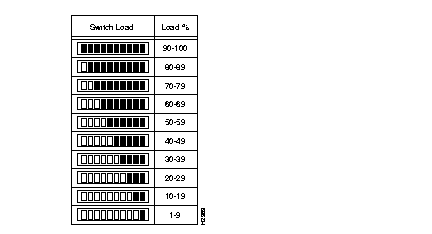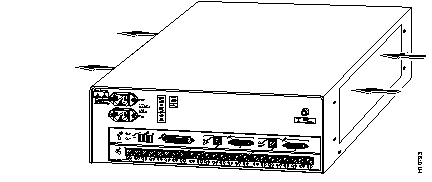|
|

This chapter describes the features and the hardware components of the Catalyst 2926 switch and includes the following sections:
This section describes the Catalyst 2926 switch hardware features. For software feature descriptions, refer to the Catalyst 5000 Series Advanced Software Configuration Guide. For configuration information specific to the Catalyst 2926 switch, refer to the Release Notes for Catalyst 5000 Series Software Release 2.4(1).
The Catalyst 2926 switch employs a 1.2-Gbps, media-independent backplane. The backplane provides the connection between the supervisor engine, the 10/100-Mbps Fast Ethernet autosensing switched ports, and the power supplies. The switching fabric supports Fast Ethernet switched interfaces.
Much of the functionality of the Catalyst 2926 switch can be summarized as features of the supervisor engine. These features include the following:
The Catalyst 2926 switch architecture is based on high-speed switching network principles, using a queuing model for input. Each switch port maintains its own frame buffer memory. Each frame is stored in a frame buffer before it is forwarded to the next port.
Bus arbitration and hardware-based switching are shared among all ports. Together, they control the destination of packet transfers and access to the data switching bus. The switch uses central bus arbitration and address recognition logic. Multiple copies are not required for high-speed broadcast and multicast frame forwarding because all ports simultaneously receive the same copy of the frame when it is sent on the backplane.
The Catalyst 2926 switch media-independent backplane supports a three-level priority request scheme. Two priorities are user-selected, and the third is backplane-based. The buses allow each port to perform a local flush and maintain a packet retry mechanism for outbound port congestion.
Hardware-based switching is a Catalyst 2926 switch feature similar to the learning bridge or content-addressable memory (CAM) of other types of network switches and routers. Hardware-based switching automatically learns source MAC addresses and VLAN and port information and saves them in a RAM address table. Hardware-based switching uses learned entries to forward packets to their destination addresses. The supervisor engine has a features card that accommodates all the core switching logic.
For maximum network performance, the Catalyst 2926 switch contains dual AC-input power supplies.
Environmental monitoring functions constantly monitor the internal temperature of the chassis. Each power supply monitors its own voltage and temperature and shuts itself down if it detects a critical condition. The reporting functions enable you to retrieve and display the present values of measured parameters, and the reporting functions display alarms on the console if any of the monitored parameters exceed defined thresholds.
The processor monitors the temperature inside the chassis, and the power supplies use the normal and critical levels to monitor power supply voltages. If the temperature exceeds a defined threshold within a power supply, the power supply turns off. If both power supplies turn off, the switch shuts down. Refer to the section "Power Supplies" in this chapter for temperature and voltage thresholds for the processor-monitored levels.
The environmental monitoring functions use the following three status levels to monitor the system:
The processor uses two levels of status conditions (normal and alarm) to monitor the air temperature in the chassis. Sensors on the supervisor engine monitor the temperature of the cooling air that flows through the chassis. If the air temperature exceeds a defined threshold, the system processor indicates an alarm condition using the supervisor engine status LED, SNMP traps, and command-line interface (CLI) displays. The processor stores the present alarm configuration in NVRAM. Information about these alarms can be retrieved later as a report of the last shutdown parameters.
The embedded Flash memory allows you to load and store system software images remotely. You can download a new software image over the network or from a local Trivial File Transfer Protocol (TFTP) server and add the new image to Flash memory or replace an existing file.
An electronically erasable programmable read-only memory (EEPROM) component on the supervisor engine stores interface-specific information, such as the 10/100-Mbps Fast Ethernet interface board serial number, part number, controller type, hardware revision, configuration information, and other details unique to the interface board. The EEPROM also contains an address allocator, which is a bank of 1024 hardware or MAC-level addresses, one for each possible VLAN in the system.
This section describes the Catalyst 2926 switch hardware components.
Two versions of the supervisor engine are available, as follows:


 | Warning Class 1 laser product. |
 | Warning Because invisible laser radiation may be emitted from the aperture of the port when no cable is connected, avoid exposure to laser radiation and do not stare into open apertures. |
The LEDs on the front panel of the supervisor engine indicate the status of the system, which includes the supervisor engine, the power supplies, and the fan assembly. Figure 2-3 shows the location of the LEDs and Table 2-1 describes their operation.

| LED | Description |
|---|---|
| STATUS | The switch performs a series of self-tests and diagnostic tests. If all the tests pass, the LED is green. If any test fails, the LED is red. During system boot or if the interface card is disabled, the LED is red. If the redundant power supply is installed but not turned on or receiving input, the LED is red. If the fan module fails, the LED is orange. |
| FAN | Indicates whether or not the fan is operational. If the fan is operational, the LED is green. If the fan is not operational, the LED is red. |
| PS1 | If the power supply associated with the bottom AC receptacle is operational, the LED is green. If the power supply associated with the bottom AC receptacle is not operational or not receiving input power, the LED is red. |
| PS2 | If the power supply associated with the upper AC receptacle is operational, the LED is green. If the power supply associated with the upper AC receptacle is not operational or not receiving input power, the LED is red. |
| ACTIVE | If the supervisor engine is operational and active, the LED is green. If the supervisor engine is in standby mode, the LED is orange. |
| SWITCH LOAD | If the switch is operational, the LED bar provides a visual indication (as an approximate percentage) of the current traffic load over the backplane (see Figure 2-4). |
| 100 MBPS | If the port is operating at 100 Mbps, the LED is green. |
| LINK | If the port is operational, the LED is green. If the link has been disabled by software, the LED is orange. If the link is bad and has been disabled due to a hardware failure, the LED flashes orange. If no signal is detected, the LED is off. |
The RESET button (see Figure 2-3) allows you to restart the switch.
The SWITCH LOAD display (see Figure 2-4) provides a visual approximation of the current traffic load across the backplane.

The CONSOLE port (see Figure 2-3) is a data communications equipment (DCE) DB-25 receptacle, which supports a DCE EIA/TIA-232 interface.
The console port enables you to perform the following functions:
For detailed information on using the console port, refer to the section "Connecting a Terminal to the Console Port" in Chapter 4, "Installing the Switch."
The supervisor engine Fast Ethernet ports (see Figure 2-1 through Figure 2-3) operate in full- or half-duplex mode. These ports support the following connectivity:
For detailed information on using these ports, refer to the section "Connecting to the Supervisor Engine Ports" in Chapter 4, "Installing the Switch."
The Catalyst 2926 switch includes 24 autosensing, 10/100-Mbps Fast Ethernet switched ports (10/100BaseTX) that can operate in full- or half-duplex mode using Category 5 unshielded twisted-pair (UTP) cabling with RJ-45 connectors.
Figure 2-5 shows the RJ-45 connectors and LEDs for the 10/100-Mbps Fast Ethernet autosensing switched ports available with the Catalyst 2926 switch.

The Catalyst 2926 switch faceplate contains a STATUS LED for overall status of the 10/100-Mbps autosensing switched ports and an LK (link) and SP (speed) LED for each autosensing switched port. The LEDs are shown in Figure 2-6 and are described in Table 2-2.

| LED | Description |
|---|---|
| STATUS | The switch performs a series of self-tests and diagnostic tests. If all the tests pass, the LED is green. If a test other than an individual port test fails, the LED is red. During system boot or if the board containing the 10/100-Mbps ports is disabled, the LED is orange. During self-test diagnostics, the LED is orange. If the board containing the 10/100-Mbps ports is disabled, the LED is orange. |
| LK | If the port is operational (a signal is detected), the LED is green. If the link has been disabled by software, the LED is orange. If the link is bad and has been disabled due to a hardware failure, the LED flashes orange. If no signal is detected, the LED is off. |
| SP | If the port is operating at 100 Mbps, the LED is green. If the port is operating at 10 Mbps, the LED is off. |
For specifications on the 10/100-Mbps Fast Ethernet autosensing switched ports, see Appendix A, "Technical Specifications."
The system fan assembly provides cooling air for the supervisor engine, the 10/100-Mbps Fast Ethernet autosensing switched ports, and the backplane. The fan assembly is located in the chassis.
Figure 2-7 shows the direction of airflow in to and out of the switch.

If an individual fan within an assembly fails, the fan LED on the supervisor engine turns red. The supervisor engine fan assembly LED is described in Table 2-1.
Sensors on the supervisor engine monitor the internal air temperatures. If the air temperature exceeds a desired threshold, the environmental monitor displays warning messages. For specific threshold and status level descriptions, refer to the section "Environmental Monitoring" in this chapter.
The Catalyst 2926 switch has two internal AC-input power supplies. Each power supply has a status LED on the supervisor engine.
The dual AC-input power supplies normally operate in a load-sharing mode. In normal operation, each power supply concurrently provides approximately half of the required power to the system. If one power supply fails, the second power supply immediately assumes full power to maintain uninterrupted system operation. Load sharing and fault tolerance are automatically enabled.
The front panel of the supervisor engine has two LEDs (PS1 and PS2) that indicate the status of the power supplies. These LEDs are described in Table 2-1.
|
|